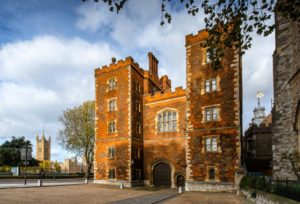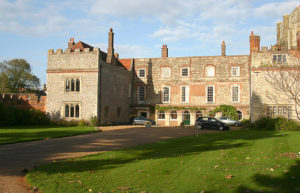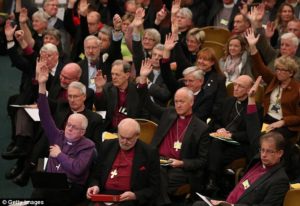 A lingering issue that will remain after all the actors in the present Church abuse dramas are long gone, is the way that holiness and evil are sometimes messily combined. Peter Ball and many other abusers before him (and since) have groomed victims by using the resources of organised religion. This makes the victims far easier to abuse. As a comment, someone on another blog, when discussing the fall from grace of Bill Hybels, the Willow Creek founder, pointed out: ‘organised religion does two thirds of the work of grooming’. In short religious ideas and beliefs can do much of the work in making a victim compliant to the evil desires of an abuser.
A lingering issue that will remain after all the actors in the present Church abuse dramas are long gone, is the way that holiness and evil are sometimes messily combined. Peter Ball and many other abusers before him (and since) have groomed victims by using the resources of organised religion. This makes the victims far easier to abuse. As a comment, someone on another blog, when discussing the fall from grace of Bill Hybels, the Willow Creek founder, pointed out: ‘organised religion does two thirds of the work of grooming’. In short religious ideas and beliefs can do much of the work in making a victim compliant to the evil desires of an abuser.
Peter Ball clearly was able to hide his nefarious designs under the cloak of the monastic tradition with its traditional emphasis on self-sacrifice and physical deprivation. Cold showers and long periods of prayer ‘softened up’ victims and helped to make them totally dependent on Ball as their spiritual guru. The more each victim tolerated this hard and physically-tough regime, the more they were susceptible to complete obedience to every command Ball gave them. This, of course, in the end led to some ‘allowing’ Ball to abuse them. Later the victim was naturally fairly confused as to what in fact had taken place. Were they in some way complicit? I can imagine that Ball kept the boundaries between good and evil deliberately confused for his victims. An abuser will often project shame on to his victims so that everything becomes unclear in the victim’s mind. The abused individual will experience a strong sense of shame along with all the rest of the pain and guilt that are part of the survivor’s burden. Meanwhile we might wonder what is going on inside the head of an abuser when he has aligned himself with a religious narrative to justify his nefarious behaviour. Certainly, according to reports, remorse was never shown by Ball in the period leading up to his trial. In the absence of any expressed regret, we have to suggest that maybe the epithet ‘psychopath’ is an appropriate description of his behaviour. In Christian language, a psychopath is someone who lacks conscience and remorse. The thought that God and psychopathy are combined in an individual is an unbearable and almost unthinkable notion. But it is the only hypothesis that fits the known facts. When holiness and utter evil are combined it represents a challenge for theological thinking. How can we ever reconcile these two completely polar-opposites?
During the 90s George Carey and many other church people were unable to imagine that apparent sanctity and evil could combine in the same individual. ‘Holy people never behave like that’ might have been the cry. But there is another story from the 90s, equally disturbing, that should have alerted us all to this possible combination of evil and spirituality. It is the story of the Nine O Clock Service in Sheffield. The existence of NOS, as it became known, was a shot in the arm for many people in the Church of England who wanted to see a revival among young people. Based in Sheffield under the leadership of Chris Brain, the movement was highly attractive to the young and was at the cutting edge of experimental worship and liturgy. For a time in the early 90s it was identified with a conservative charismatic theology. Brain was invited to meet Archbishop Carey and contribute to a volume of essays edited by him on the Decade of Evangelism. Later Brain’s theology was shifted to being associated with a strand of thinking known as Creation Spirituality. This had been started in the States by one Matthew Fox. There is a great deal more that could be said about NOS but, for the purposes of this post, we should reflect on the way that it became ‘fashionable’ across the church because it appeared to be successful. Peter Ball’s ‘Give a Year for God’ had been welcomed uncritically because it was apparently making monastic traditions ‘work’ for a swathe of young men. NOS was also welcomed because it and its imitators across the country attracted many young people to its night club worship environment. It was creative and original. Brain attracted a great deal of musical and artistic talent into his organisation. He himself was allowed rapidly to proceed to ordination in the Anglican Church as a way of claiming this whole movement for the national church.
The end of NOS came suddenly in the summer of 1995. While Brain was out of the country a group of women plucked up courage to report to the church authorities that each of them had been sexually abused by Brain over a period of years. The total affected was around 40. Almost over-night NOS came to a grinding halt. In Gloucestershire where I was working at the time, the NOS-type services also ceased. They had been virtually the main effort of our enthusiastic Diocesan youth worker. I never attended one of his events, but I understand that clever light effects and the use of dry ice were a feature of what was on offer for the young people. They certainly enjoyed the experience.
The failure of NOS was not a failure of experimental worship any more than monasticism was discredited by Ball’s abuse of the tradition. Both men, Ball and Brain, had taken these along with their personal charisma, and used them as instruments for personal gratification. I have written many times about the power of charisma. Charisma is a power of personality held by a leader. Through it followers or disciples can be inspired to believe great things of themselves or of a cause held up before them. Charisma can operate equally well in religious or non-religious settings. Where religious charisma is in operation it does not become necessarily holy and good. Secular charisma can also work well or badly according to the motivation of its possessor. What was needed in the 90s Church of England as well as today was a better understanding of the way charisma works. Good things within the context of charisma can be tangled up very quickly with evil and acts of sexual gratification. The Church of England has always been drawn to ‘success’ in terms of numbers attending an event like a moth attracted to a flame. Popularity, charisma and success carried Ball and Brain along for several years unchallenged. The consequent damage to the institution when their true motivations were exposed was appalling. Each was guilty of serious wrong-doing. In one case, that of Ball, we have had an independent inquiry investigating the institutional failures involved. In the other example nothing has been done. Everyone has retreated back into a collective amnesia with the hope that the past is past and no one will remember the pain of the victims and the shocking failures of oversight. Brain disappeared abroad to the States and no doubt to this day he is being supported by rich influential contacts. At the very least we can trust that the Church of England has remembered to put in place some injunction that will protect future generations of Christians from this kind of exploitative behaviour. We desperately need to know that the Church has ‘learned the lessons’. From the experience of the past few months, we cannot be confident that this is indeed the case.






